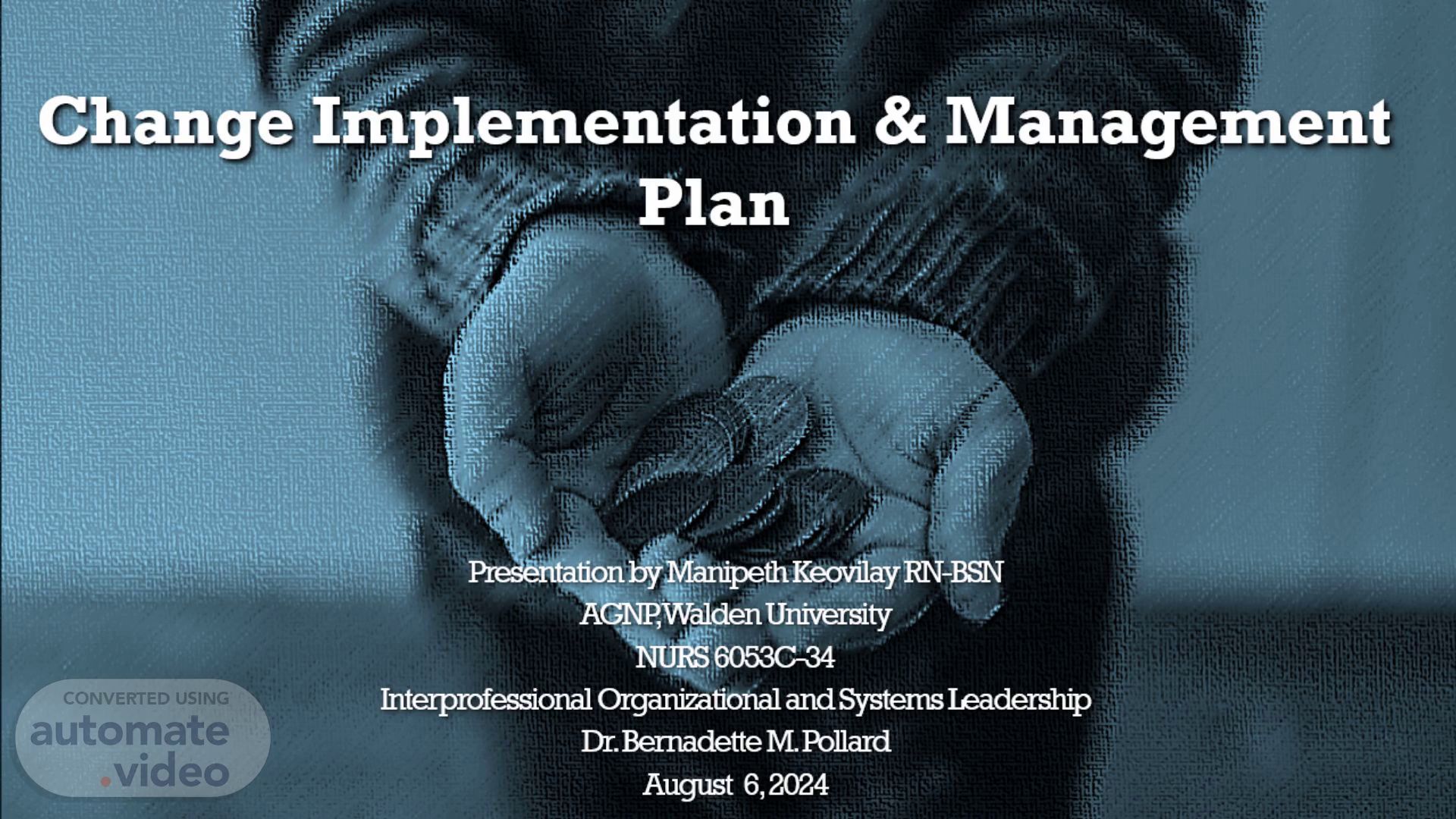
An Organizational Change Implementation and Management Plan
Scene 1 (0s)
An Organizational Change Implementation and Management Plan.
Scene 2 (14s)
Executive Summary. 2. Employee engagement, morale, job satisfaction, performance, and intent to stay directly reflect an organization’s performance (Wei et al., 2023). Problem: A recent Clark Healthy Workplace Inventory survey indicates that staff of BHSF are committed but are less satisfied with specific facets of their job including pay, communication, and feeling valued as assets to the organization. Solution: Boost employee morale using clear communication, create a positive work environment, and set reasonable goals and expectations. Cultivate open communication for employees to voice their concerns and provide the support needed for staff to perform jobs at their optimal level Linking each employee’s role to the overall mission of the healthcare organization is critical. Set clear values and mission of the organization with clear and specific expectations. Goal: Align the organization's and employees' mission and vision to provide quality care and optimal performance..
Scene 3 (54s)
Proposed Change Strategy. 3. Staff Engagement and Good Morale: teamwork higher productivity increased employee engagement improved employee retention better reflection of the organization To thrive, employees must feel supported, respected, appreciated, and motivated..
Scene 4 (1m 29s)
Cultural organizational change. 4. Systematic Approach to Implement a Culture Inclusive of Its Members. Shared Leadership. A Common Shared Vision and Mission allows staff to feel as though their contributions truly make a difference. Open lines of Communication for staff and leadership as well as executives to connect, letting staff feel heard. Boost morale by empowering staff with resources and capability for EBP decision-making. Formal and informal employee communication has evolved in reaction to business and marketing environment changes, resulting in a trend toward strategically aligning with the organization’s aims and values. (Sulaiman et al., 2023).
Scene 5 (1m 57s)
Stakeholders. 5. Interdisciplinary Team Nurse Leadership Clinical Nurse Staff Front-line Workers Community of the Organization Patients Executives of the Organization (Wang, 2022)..
Scene 6 (2m 24s)
Plan to Communicate. 6. Step 1: Identify the target audience: Determine the key stakeholders who need to be informed and involved in the change. This may include employees, managers, executives, and external partners. Step 2: Use transparent communication. Key factors: Participation, Accountability, and Substantiality. Participation entails stakeholders' involvement. Accountability requires organizations to take responsibility for their actions. Substantiality involves providing truthful, substantial, and valuable information. Shared information should meet the recipient's needs for totality (Hadziahmetovic & Salihovic, 2022). Step 3.: Select appropriate communication channels: Adapting the methods to each audience ensures the message is delivered effectively. To maximize impact, it's crucial to select a credible source or thought leader to effectively communicate a change to peers (Boustani et al., 2020). Step 4: Create a two-way communication process: Encourage feedback, questions, and suggestions from employees. This engages the staff, ensuring that their concerns are heard and addressed throughout the change process. Opens up channels for a shared solution (Harris, 2024). Step 5: Establish a timeline: Communicate established key milestones of the initiative. Keep employees informed about the progress and updates. This can help with risk management..
Scene 7 (3m 16s)
Risk Mitigation Plan. 7. Comprehensive communication plan: Develop a clear and consistent communication plan to keep staff informed about the change, its benefits, and its timeline. Stakeholder engagement: Involve key stakeholders in the planning and implementation process to gain their support and address their concerns. Training and development: Provide adequate training to all staff on new processes, technologies, and expectations. Pilot Test. Leadership development: Invest in leadership development programs to equip managers with the skills to effectively lead and support their teams through the change. Resource allocation: Allocate sufficient resources, including time, money, and personnel, to support the change effort. Performance monitoring and feedback: Regularly monitor progress and gather feedback from staff to identify and address any issues that arise. (Dudley, 2024)..
Scene 8 (3m 55s)
CONCLUSION. Properly assess the organization’s current status. Choose the appropriate plan based on the needs and status of the organization. Identify the key players. Budget and finance Communicate. Risk Management: Pilot test run Feedback Reassess. Make changes necessary for success..
Scene 9 (4m 12s)
REFERENCES. Broome, M., & Marshall, E. S. (2021). Transformational leadership in nursing: From expert clinician to influential leader (3rd ed.). New York, NY: Springer. Boustani, M., Azar, J., & Solid, C. A. (2020). Agile implementation: A model for implementing evidence-based healthcare solutions into real-world practice to achieve sustainable change. Morgan James Publishing. Dudley, J. (2024). Employee engagement in 2024: Trends, challenges, and opportunities. PressGaney. https://info.pressganey.com/press-ganey-blog-healthcare-experience-insights/employee-engagement-in-2024-trends. Hadziahmetovic, N., & Salihovic, N. (2022). The Role of Transparent Communication and Leadership in Employee Engagement. International Journal of Academic Research in Economics and Management and Sciences. 11(2), 558 - 571. Harris, L. (2024). Effective management strategies to increase employee engagement. [Doctoral dissertation, Walden University]. ScholarWorks. https://scholarworks.waldenu.edu. Sulaiman, N., Abdullah, Z., & Man, I. (2023). The effects of employee communication and engagement on organizational performance: A conceptual study. International Journal of Accounting, Finance and Business 8(46). https://Doi:10.5573/IJAFB.084616. Wang R. (2022). Organizational Commitment in the Nonprofit Sector and the Underlying Impact of Stakeholders and Organizational Support. Voluntas: International Journal of Voluntary and Nonprofit Organizations, 33(3), 538–549. https://doi.org/10.1007/s11266-021-00336-8. Wei, H., Horsley, L., Cao, Y., Haddad, L. M., Hall, K. C., Robinson, R., Powers, M., & Anderson, D. G. (2023). The associations among nurse work engagement, job satisfaction, quality of care, and intent to leave: A national survey in the United States. International Journal of Nursing Sciences, 10(4), 476–484. https://doi.org/10.1016/j.ijnss.2023.09.010..